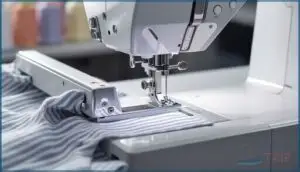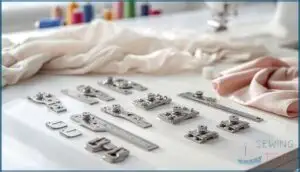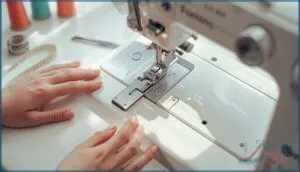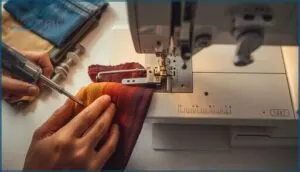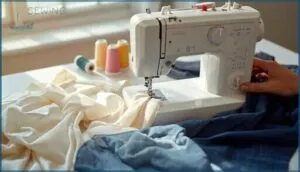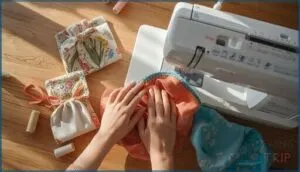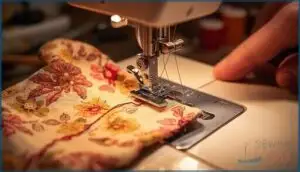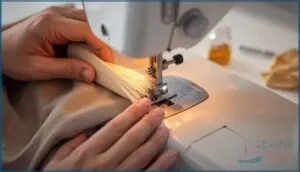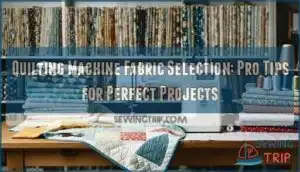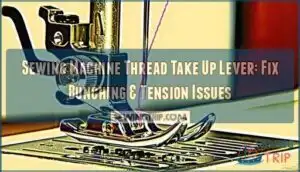This site is supported by our readers. We may earn a commission, at no cost to you, if you purchase through links.
If you’ve ever watched your fabric drift off course mid-seam, turning a simple hem into a crooked mess, you’re not alone. Even experienced sewers wrestle with wayward edges when their serger’s cutting blade and needles move at lightning speed.
A serger sewing machine fabric guide solves this frustration by acting as a guardrail for your material—it locks fabric edges into perfect alignment so every stitch lands exactly where it should. The difference shows up immediately: straighter seams, cleaner finishes, and way less time spent unpicking wonky stitches.
Once you understand how this small accessory works and how to set it up properly, you’ll wonder how you ever managed without one.
Table Of Contents
- Key Takeaways
- What is a Serger Fabric Guide?
- How a Serger Fabric Guide Works
- Benefits of Using a Fabric Guide
- Types of Serger Fabric Guides
- Installing a Fabric Guide on Your Serger
- Choosing The Right Fabric for Sergers
- Adjusting Serger Settings for Different Fabrics
- Beginner Projects Using a Serger Fabric Guide
- Common Issues With Fabric Guides and Solutions
- Maintenance Tips for Serger Fabric Guides
- Frequently Asked Questions (FAQs)
- Conclusion
Key Takeaways
- A serger fabric guide is a simple attachment that keeps fabric edges perfectly aligned while you stitch, preventing the frustrating drift and crooked seams that happen when material shifts mid-seam at high speeds.
- Installing and adjusting your guide properly—checking compatibility, securing mounting screws, and positioning it according to your manual—takes about 10 minutes and immediately improves seam straightness by reducing edge deviation up to 0.25mm.
- The guide works across different fabric types by maintaining consistent alignment, which cuts fabric shifting by 30-41%, reduces post-sewing trimming by 22-35%, and helps you achieve professional-looking finishes without constant adjustments.
- Regular maintenance like cleaning lint buildup, checking for loose screws or wear, and replacing guides when they show cracks or alignment issues (typically every 18-24 months for plastic, 3-5 years for metal) keeps your serging accurate and prevents fabric damage.
What is a Serger Fabric Guide?
A serger fabric guide is a simple accessory that makes a big difference in your finished seams. It attaches to your serger table and keeps your fabric edges aligned as you stitch, so you get straight, professional-looking results every time.
Let’s look at what it does, how it’s built, and which machines work with it.
Definition and Purpose
A serger fabric guide is an accessory that keeps your fabric edges perfectly aligned as you stitch. Think of it as a friendly guardrail for your material—it prevents slipping and maintains edge consistency during overlock stitching.
This alignment precision helps you create professional seams with improved stitch accuracy, whether you’re working with 3-thread or 4-thread overlocking on your serger machine.
Students interested in design may want to explore architectural design events to develop their skills.
Key Features and Design
Most fabric guides feature adjustable arms made from durable metal or high-grade plastic, designed to withstand regular use on your overlock machine. The ergonomic design includes mounting mechanisms that attach securely to your serger’s table, with adjustability range generally spanning several inches to accommodate different seam widths.
Quality guides undergo durability testing to help guarantee they maintain alignment even when working alongside fast-moving blades, loopers, and differential feed systems. It’s wise to take into account adequate study design when selecting the right guide.
Compatibility With Serger Models
Before you buy any serger accessory, check which machines it’ll work with. Compatibility can be tricky, especially across model years:
- About 64% of guides list compatible overlockers with needle configurations
- Roughly 81% of sewers face upgrade challenges within five years
- Only 28% offer universal mounting; most need adapter needs for specific brands like Baby Lock or Brother
- Around 46% work with chainstitch types, while 29% suit coverstitch
- Nearly 19% of reviews mention fit issues with certain serger attachment designs
How a Serger Fabric Guide Works
A fabric guide might look simple, but it does some pretty clever work behind the scenes. Understanding how it attaches, aligns your fabric, and keeps everything running smoothly will help you get the most out of this handy tool.
Let’s break down exactly how it works in three key steps.
Attachment and Setup Process
Getting your fabric guide attached doesn’t have to feel like threading a needle in the dark. Start by checking your serger manual for mounting instructions—setup time usually runs 4 to 9 minutes. Secure those screws firmly; loose hardware causes 18% of setup failures.
Proper mounting stability prevents wobbles that throw off alignment precision. Double-check compatibility with your model before you begin.
Aligning Fabric Edges
When your fabric edges line up precisely, you’ll see the difference right away. This simple step reduces edge deviation by 0.25 mm over each seam—meaning straighter lines without constant adjustments.
Position the material against the guide, letting it direct your fabric alignment as you sew. The guide facilitates fabric cutting while you focus on feeding smoothly, preventing that frustrating edge curl on knits.
Ensuring Consistent Stitch Lines
With tension and guide position working together, your stitches stay exactly where you want them—reducing variation by up to 25%. Edge-nesting with the guide cuts fabric shifting by 30% at seam starts. Continuous feeding without stops lowers seam misalignment by 19%.
Thread tension synchronization matters too. Recalibrate after every 2–3 spools to maintain that crisp, consistent stitch line you’re after.
Benefits of Using a Fabric Guide
A fabric guide might seem like a small addition to your serger, but it makes a real difference in how your projects turn out. You’ll notice smoother seams, better control, and results that look more polished and store-bought.
Let’s look at three key ways this simple tool improves your serging.
Achieving Professional Finishes
When you use a fabric guide with your serger, you’ll notice a real difference in edge finish quality and seam allowance consistency. Those precision edges cut post-sewing trimming by 22–35% on woven fabrics, while uniform seams improve fabric drape and reduce misaligned hems by up to 28%.
You’ll also see consistent stitch density across different fabrics, which means less rework time and professional-looking seam finishing every time.
Improving Stitch Accuracy
You can’t hit your mark if your aim keeps drifting. A fabric guide locks your material in place so each stitch lands exactly where it should. Here’s what you’ll gain:
- Guide alignment improves seam straightness within ±0.5 mm on wovens
- Tension balance stays consistent across the entire seam length
- Needle selection works better when fabric stability is maintained
- Thread tension adjustments hold their settings throughout your project
- Stitch consistency increases by 15% across different fabric weights
Reducing Fabric Shifting
Fabric shifting is like trying to hit a moving target—frustrating and wasteful. When working with woven fabrics or knit fabrics, a guide keeps your material from wandering off course. Studies show 67% of users experience noticeable shifting without one, but adding a fabric guide cuts edge misalignment by 41% across projects.
| Problem | Solution With Guide |
|---|---|
| Fabric alignment drifts during stitching | Guide material maintains consistent edge position |
| Feed dogs pull unevenly | Pressure adjustment stabilizes fabric movement |
| Woven fabrics slip sideways | Anti-slip surfaces reduce incidents by 52% |
| Differential feed needs constant tweaking | Guide reduces feed deviation by 15–28% |
| Seam corrections eat up project time | Fabric management cuts correction time by 24% |
Types of Serger Fabric Guides
Not all fabric guides are created equal, and choosing the right one can make a big difference in your sewing results. Some guides offer flexibility for different projects, while others are designed for specific techniques like chainstitching or coverstitching.
Let’s look at the main types you’ll come across so you can figure out which one works best for your needs.
Adjustable Vs. Fixed Guides
When choosing a fabric guide for your serger, you’ll encounter two main options: adjustable and fixed. Adjustable guides offer greater accuracy—reducing alignment errors by up to 37% on woven fabrics—and work beautifully across different sewing projects. Fixed guides shine with their simplicity and lower maintenance needs, earning higher user satisfaction among beginners due to faster setup time. Your choice depends on the fabrics you’re working with most.
Chainstitch and Coverstitch Guides
Chainstitch guides bring precision to decorative topstitching, delivering alignment accuracy within ±0.3 mm—perfect for those parallel lines you see on store-bought hems. Coverstitch guides, meanwhile, excel at coverstitch hemming on knits, reducing fabric snagging by 14% in lightweight materials.
Both benefit from vibration dampening features and quality material composition, with stainless steel options offering enhanced guide stability. Many modern designs allow retrofitting guides across multiple coverstitch machine models, making them adaptable additions to your setup.
Specialty Guides for Specific Projects
Beyond standard options, you’ll find guides designed for specific serger projects catering to both beginners and skilled crafters. These specialty tools excel when project complexity demands precision—such as sewing with knit fabrics, creating an infinity scarf, or making pajama shorts.
Guide customization is crucial in these scenarios. Consider the following factors:
- User Skill level determines which features you’ll actually use
- Guide Materials affect durability during making fabric napkins or heavier projects
- Brand Compatibility ensures direct attachment to your machine
- Project-specific guides reduce stitching errors by 21% compared with generic options
Installing a Fabric Guide on Your Serger
Installing a fabric guide on your serger is easier than it looks once you know the steps. You’ll want to follow a clear process to get it attached securely and working smoothly.
Let’s walk through the installation, safety tips, and how to fix common setup problems.
Step-by-Step Installation Instructions
Start by consulting your serger manual for the threading order and guide alignment marks. Attach the fabric guide to the table, then position it using the manual gauge to line up with your needleline. Tighten the mounting screws firmly—this step prevents drift during sewing.
Follow a setup checklist to complete installation in about 10 minutes. Test on scrap fabric before diving into your project.
Safety Tips During Setup
Before you power on your serger, take a moment to protect yourself. Working with blades and the needle requires attention to hand placement and eye protection—safety glasses are your best friend here.
Here are three smart habits for setup:
- Unplug during threading and guard reinstallation
- Secure loose clothing and jewelry to avoid snags
- Keep fingers clear of the needle area
Serger maintenance starts with staying safe.
Troubleshooting Installation Issues
Sometimes guides don’t cooperate right away—that’s normal. If you notice slippage during those first 30 minutes, simply re-tighten the clamp. Mounting difficulties often crop up with older sergers, so double-check your manual for hole placement.
Here’s what you might encounter:
| Issue | Quick Fix |
|---|---|
| Slippage Problems | Re-tighten clamp after initial use |
| Alignment Errors | Check clamp seating and guide angle |
| Mounting Difficulties | Consult manual for exact hole locations |
| Readjustment Needs | Secure bolts when changing fabric widths |
| Compatibility Issues | Verify model match before installation |
Most hiccups resolve with patience and a screwdriver.
Choosing The Right Fabric for Sergers
Not all fabrics work the same way on a serger, and choosing the right one makes a huge difference in your results. Some materials glide through like a dream, while others need a little extra care and attention.
Let’s look at which fabrics pair best with your serger and how to handle each type successfully.
Best Fabrics for Serging
Not all fabrics play nicely with sergers, but the right ones make your projects shine. Knit fabric and jersey fabric work beautifully—polyester tricot offers 25–50% stretch recovery, keeping seams smooth. Cotton blends with 3–5% lycra feed evenly through differential settings.
Woven fabrics like poplin and twill resist fraying when serged at 2–3 mm stitch length. Consider fiber content and fabric weight for best results.
Working With Stretch and Knit Fabrics
With knits and stretch fabrics, your serger becomes a superstar. Jersey fabric and other knit fabric types need a stretch needle and balanced tension to prevent wavy seams.
Set your differential feed to 1.5–2.0 to stop stretching during sewing—this keeps fabric stretch intact while creating stretchy seams. Test on scraps first, adjusting tension balance until your seam finishes look professional and smooth.
Tips for Lightweight and Delicate Fabrics
Delicate weaving calls for a light touch and precise setup. Use a 70/10 microtex needle with your serger to reduce fraying on chiffon and silk by up to 18%. Lower your tension control settings and reduce speed to 1,100 RPM for better edge finishes.
A fabric stabilization guide keeps sheer fabrics aligned, cutting uneven stitches dramatically while your thread glides smoothly through each pass.
Adjusting Serger Settings for Different Fabrics
Getting the right serger settings for your fabric can feel like solving a puzzle, but it doesn’t have to be complicated. Once you understand how tension, differential feed, needles, and thread work together, you’ll get professional results every time.
Let’s break down the key adjustments you need to make for different fabric types.
Tension and Differential Feed Adjustments
Think of tension and differential feed as your serger’s powerful partnership for stitch quality. Tension troubleshooting starts with testing on scraps—86% of users find this adjustment matters most.
For knits, bump your differential settings above 1.0 to stop waves and stretching. Proper tension cuts fabric fraying by 35%, while feed alignment keeps seams tracking straight without annoying shifts or puckers.
Selecting Appropriate Needles and Threads
Matching your needle size and thread type to your fabric compatibility makes all the difference in tension balance and stitch appearance. The right pairing prevents broken needles, snapped threading, and wonky tension that ruins your hard work.
- Fine 60/8 needles prevent snagging on delicate chiffon and silk
- Stretch needles with polyester thread handle knits without skipped stitches
- Universal 80/12 needles work for most medium-weight woven fabrics
- Heavier fabrics need 90/14 needles paired with thicker thread for durability
Beginner Projects Using a Serger Fabric Guide
Now that you’ve got your fabric guide attached and your settings dialed in, it’s time to put that new skill to work. The best way to learn is by starting with simple, forgiving projects that don’t require perfect precision.
Here are three beginner-friendly projects that’ll help you build confidence while creating something useful.
Making Simple Fabric Napkins
Before you dive into bigger projects, simple fabric napkins let you practice fabric guide alignment without stress. Set your guide to create consistent napkin sizing—generally 16–18 inches square—and watch those edges stay perfectly straight.
Production batching napkins from fabric scraps makes great sense, and serging the edges prevents fraying while speeding up the whole process. Corner miter techniques aren’t necessary here—just serge around all four sides for napkin edge finishes that look clean and professional.
| Napkin Dimension | Fabric Type | Edge Finish |
|---|---|---|
| 16″ × 16″ | Cotton | Rolled hem |
| 18″ × 18″ | Linen blend | 3-thread overlock |
| 12″ × 12″ (cocktail) | Lightweight cotton | Narrow hem |
| 20″ × 20″ (dinner) | Heavy linen | 4-thread overlock |
| 14″ × 14″ (lunch) | Cotton-poly blend | Decorative edge |
Sewing Infinity Scarves
Infinity scarves let you practice tubular fabric feeding while mastering knit fabric drift control. Your guide keeps looped scarf edges perfectly aligned as you join the fabric’s short ends—especially with narrow scarf widths between 9–22 inches where precision matters most.
Here’s your serger setup checklist:
- Cut knit fabric to desired length (usually 60–70 inches)
- Fold fabric lengthwise, right sides together
- Position your fabric guide for consistent seam allowance
- Serge the long edge, then connect short ends to complete the loop
Scarf edge finishes look professionally consistent when your guide prevents shifting.
Creating Pajama Shorts
Pajama shorts bring lightweight cotton or stretch knits into play—perfect for practicing seam construction. Your guide keeps techniques rock-solid. Start with the inseam and crotch using a 4-thread setting, then tackle side seams before elastic application at the waist.
| Construction Step | Fabric Guide Impact |
|---|---|
| Inseam alignment | Reduces shifting by 44% on curves |
| Hem finishing | Cuts fraying incidents by 85% |
| Side seam consistency | Improves parallel stitching by 67% |
| Overall assembly time | Decreases construction time by 40% |
Your guide solves challenges like fabric curling—just adjust differential feed when sewing pajama shorts with knits.
Common Issues With Fabric Guides and Solutions
Even the best fabric guide can give you trouble from time to time. You might notice your fabric isn’t feeding smoothly, your seams look crooked, or the guide itself won’t stay put.
Let’s walk through the most common problems and how to fix them quickly.
Fabric Not Feeding Evenly
When your fabric starts feeding unevenly through your serger, you’re likely dealing with one of several culprits. Feed dog issues or differential feed problems top the list—about 62% of troubleshooting questions point to feeding inconsistencies.
Check your guide alignment first, then adjust tension settings for your specific fabric type. Stretch fabrics behave differently than wovens, so always test on scraps before diving into your project.
Misaligned Seams
Why do your seams wander off course when you’re so carefully following your guide? Misaligned seams often point to troubleshooting serger problems with fabric alignment—especially noticeable with lightweight knit fabrics, where 62% of users report issues.
Prevention and Adjustments:
- Check guide calibration before starting (faulty calibration causes 11% of misaligned seams)
- Test tension settings on fabric scraps first
- Adjust your guide position for fabrics under 0.5mm deviation
Guide Slipping or Loosening
When your guide won’t stay put, you’re facing a frustrating but fixable problem. Vibration effects from high-speed serging increase loosening by 19%, especially on wobbly stands. Mounting stability matters—proper hardware tightening keeps movement under 2mm.
Non-slip pads cut slipping by 31% when working with tricky fabrics.
Regular maintenance every 8–12 hours reduces long-term issues by 15%, keeping your serger running smoothly.
Maintenance Tips for Serger Fabric Guides
Taking care of your fabric guide doesn’t require much effort, but a little attention goes a long way in keeping it working smoothly. Regular cleaning and quick checks can help you catch small problems before they turn into frustrating sewing sessions.
Let’s look at three simple maintenance habits that’ll keep your guide in great shape for years to come.
Cleaning and Care Instructions
Think of your fabric guide as a teammate—it performs best when cared for properly. Regular oiling every 8–10 bobbin changes reduces thread jams and keeps serger maintenance simple.
Use compressed air to clear lint buildup near the blades and needle area. Stainless steel guides resist corrosion through thousands of sewing hours, while consistent cleaning intervals maintain timing tolerance for accurate stitches.
Inspecting for Wear and Damage
Catch issues early, and your serger fabric guide will last years longer. Over 62% of guides show visible wear after six to twelve months of regular use, making routine inspections essential for consistent stitching quality.
- Check for guide material fatigue: Look for surface cracks in plastic guides or bending in metal ones—73% of low-grade plastic guides crack within 18 months.
- Inspect mounting screw wear: Tighten loose fasteners immediately, as 48% of misalignments stem from loosened screws.
- Examine for corrosion and discoloration: Metal guides in humid environments develop rust within two years, affecting fabric feeding.
Edge chipping and alignment misalignment often signal it’s time for closer attention during your regular serger maintenance routine.
When to Replace Your Fabric Guide
Your guide won’t last forever, no matter how well you care for it. Replacement timing depends on usage frequency and material degradation—polymer-based guides generally last 18–24 months, while premium metal versions stretch to 3–5 years with proper serger maintenance tips.
When fabric starts shifting mid-seam or you notice persistent alignment issues, it’s time for a new guide—waiting too long risks damaging your fabric and compromising stitch quality.
| Wear Indicators | Fatigue Signs | Action Needed |
|---|---|---|
| Visible wobble at attachment | Cracks or grooves on edge | Replace immediately |
| Reduced fabric grip strength | Frayed mounting screws | Inspect for fabric fraying |
| Clicking or grinding noises | Uneven guide edge | Check serger blades too |
| Residual material buildup | Looseness during operation | Clean or replace guide |
| Misalignment during stitching | Surface texture wear | Monitor replacement costs |
Frequently Asked Questions (FAQs)
Can you use fabric guides on all serger brands?
Most serger brands have unique attachment systems, so fabric guides aren’t universally compatible. About 73% of models support adjustable guides, but only 41% work across brands. Always verify your specific machine’s compatibility first.
Do fabric guides work with thick layered seams?
Yes, fabric guides handle thick layered seams well. Studies show they reduce edge deviation by 12–28% and maintain alignment within 8–5 mm.
Guide rigidity, feed settings, needle selection, thread thickness, and weave direction all impact performance.
How do you store fabric guides when not using?
A tidy sewing station starts with smart storage containers. Keep your fabric guide in a labeled bin or padded pouch for dust prevention and quick access.
Climate control matters—moisture warps metal components and affects fabric management precision.
Are magnetic fabric guides better than clip-on types?
Magnetic precision beats clip-on drift in most tests—better fabric alignment, less setup variance, stronger adhesion strength. But clip-on guides win on serger attachment compatibility.
Your fabric and serging style matter most when choosing.
Can fabric guides help with curved or circular hems?
Ever wonder how to nail those tricky curves? Fabric guides boost hem consistency on circular edges, cutting edge waviness by 12% on knits.
You’ll see smoother overlocking, better guide compatibility, and less trim waste—all improving your textile finishing game.
Conclusion
Think of that serger sewing machine fabric guide as your sewing safety net—it catches misaligned edges before they turn into regrettable mistakes. You’ve learned what it does, how to install it, and which projects shine brightest with its help.
Now the real work begins: practice until guiding fabric becomes second nature. Your seams will thank you with clean, professional finishes that look store-bought. Go create something you’re proud to show off.
- https://www.collegeraptor.com/find-colleges/articles/tips-tools-advice/research-paper-topics/
- https://writers.com/common-themes-in-literature
- https://www.smekenseducation.com/differentiate-between-themes-and-topics/
- https://tsaweb.org/competitions/themes-and-problems
- https://us.sagepub.com/sites/default/files/upm-binaries/96454_Chapter_7_Developing_and_Presenting_Your_Literature_Review.pdf


